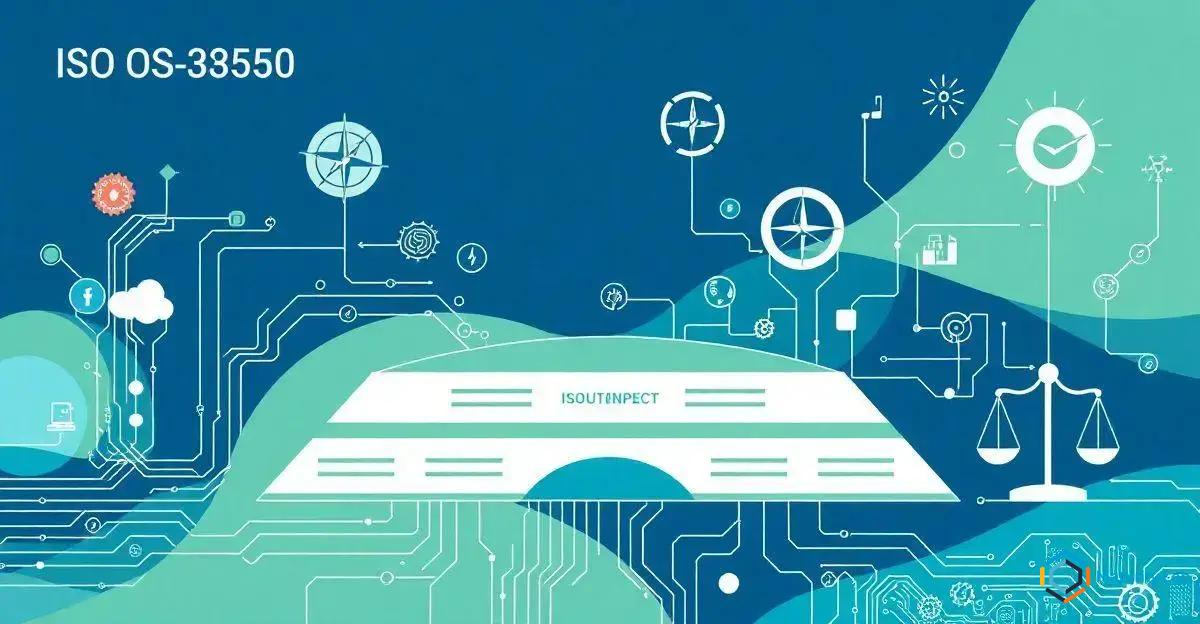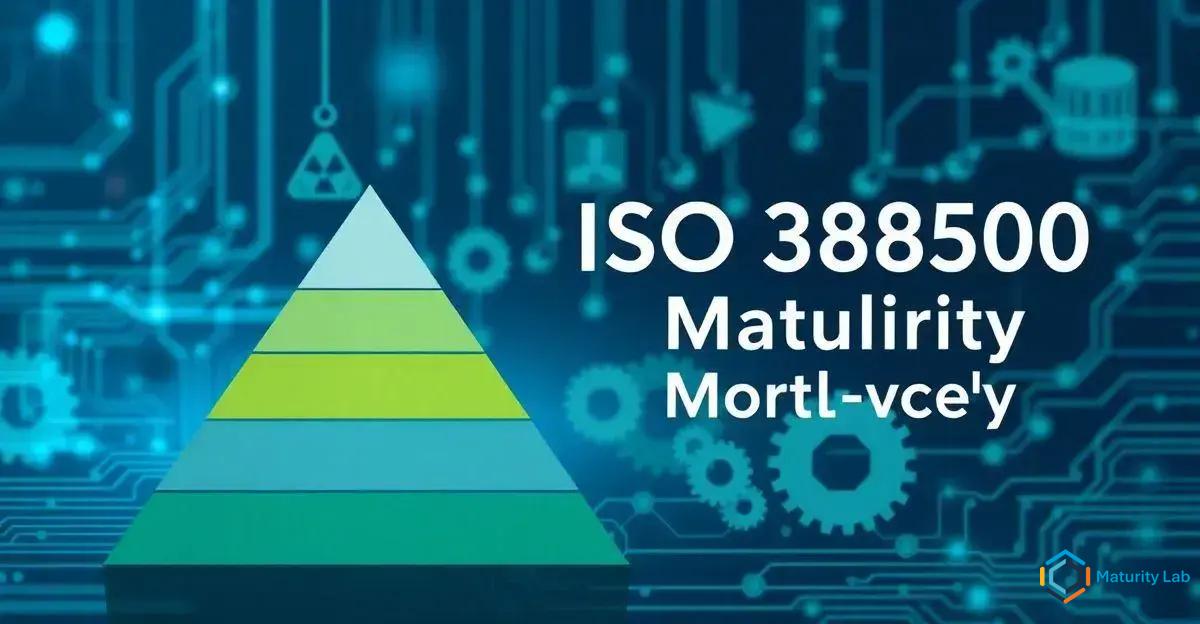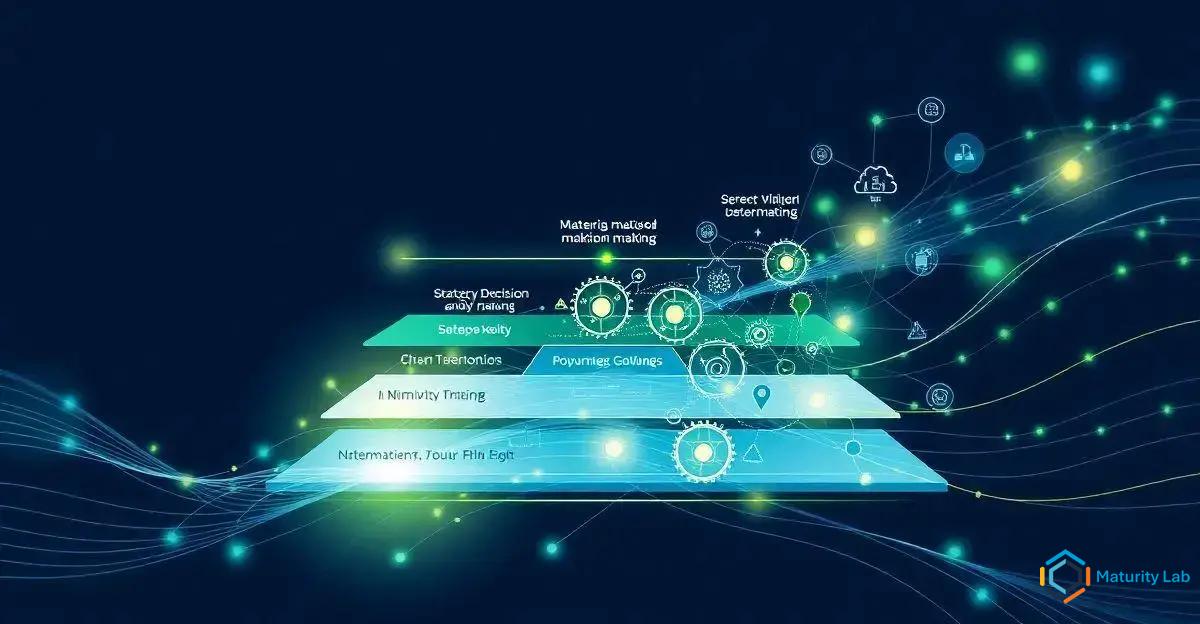The ISO 38500 Maturity Model is a framework designed to improve IT governance by aligning IT strategies with business objectives through principles such as responsibility, strategy, acquisition, performance, conformance, and human behavior. It involves assessing current practices, creating a strategic plan, establishing governance structures, and promoting continuous improvement, leading to enhanced decision making, risk management, and stakeholder confidence, ultimately optimizing IT investments for better business outcomes.
In today’s fast-paced business environment, effective IT governance and decision making are crucial for organizational success. The ISO 38500 Maturity Model provides a structured framework to evaluate and improve these critical areas. By leveraging this model, organizations can ensure that their IT governance aligns with business objectives, leading to more informed and strategic decisions. This article delves into the intricacies of the ISO 38500 Maturity Model, offering insights into its implementation, benefits, and its role in enhancing decision making.
Understanding the ISO 38500 Maturity Model

The ISO 38500 Maturity Model serves as a comprehensive framework designed to guide organizations in the governance of information technology.
It emphasizes the importance of aligning IT strategies with business goals, ensuring that IT investments deliver value and mitigate risks.
The model is structured around six key principles: responsibility, strategy, acquisition, performance, conformance, and human behavior.
Understanding these principles is fundamental to grasping the ISO 38500 Maturity Model.
The principle of responsibility ensures that individuals and groups within the organization understand their roles in IT governance.
Strategy focuses on aligning IT with the overall business strategy, ensuring that IT initiatives support business objectives.
Acquisition addresses the procurement of IT resources, emphasizing the need for informed decision making to optimize investments.
Performance is concerned with monitoring and measuring IT performance to ensure that it meets business needs and delivers expected benefits.
Conformance ensures that IT complies with relevant laws, regulations, and policies, thereby reducing risks and ensuring accountability.
Lastly, human behavior acknowledges the impact of human factors on IT governance, promoting a culture of responsibility and ethical behavior.
The ISO 38500 Maturity Model also provides a maturity scale that helps organizations assess their current level of IT governance.
This scale ranges from initial, where processes are ad hoc and chaotic, to optimized, where processes are continuously improved and aligned with business goals.
By assessing their maturity level, organizations can identify areas for improvement and develop a roadmap for enhancing their IT governance practices.
In summary, the ISO 38500 Maturity Model offers a structured approach to IT governance, emphasizing alignment with business objectives, risk management, and continuous improvement.
By understanding and applying its principles, organizations can enhance their IT governance and make more informed, strategic decisions.
Implementing the ISO 38500 Maturity Model in Your Organization

Implementing the ISO 38500 Maturity Model in your organization involves a systematic approach to ensure that IT governance is aligned with business objectives and delivers value.
The first step is to conduct a thorough assessment of your current IT governance practices. This assessment should identify strengths, weaknesses, and areas for improvement, providing a baseline for measuring progress.
Once the assessment is complete, the next step is to develop a strategic plan that outlines the goals and objectives for IT governance. This plan should be aligned with the overall business strategy and should include specific, measurable, achievable, relevant, and time-bound (SMART) goals. It is essential to involve key stakeholders in this process to ensure buy-in and support from all levels of the organization.
The implementation process
should also include the establishment of governance structures and processes. This involves defining roles and responsibilities, setting up governance committees, and developing policies and procedures that guide IT decision making. Training and awareness programs are crucial to ensure that all employees understand their roles in IT governance and are equipped with the necessary skills and knowledge.
Monitoring and measuring performance is a critical aspect of implementing the ISO 38500 Maturity Model. Organizations should establish key performance indicators (KPIs) to track progress and measure the effectiveness of IT governance practices. Regular reviews and audits should be conducted to ensure compliance with policies and procedures and to identify opportunities for improvement.
Continuous improvement is a core principle of the ISO 38500 Maturity Model. Organizations should foster a culture of continuous learning and improvement, encouraging employees to identify and implement best practices. This can be achieved through regular training, knowledge sharing, and the use of tools and technologies that support IT governance.
In conclusion, implementing the ISO 38500 Maturity Model requires a strategic and systematic approach. By conducting a thorough assessment, developing a strategic plan, establishing governance structures, monitoring performance, and fostering continuous improvement, organizations can enhance their IT governance and ensure that IT investments deliver value and support business objectives.
Benefits of ISO 38500 for IT Governance

The ISO 38500 Maturity Model offers numerous benefits for IT governance, making it an invaluable tool for organizations seeking to enhance their IT management practices.
One of the primary benefits is the alignment of IT strategies with business objectives. By ensuring that IT initiatives support the overall business strategy, organizations can maximize the value of their IT investments and achieve better business outcomes.
Another significant benefit is improved decision making. The ISO 38500 Maturity Model provides a structured framework for evaluating IT decisions, ensuring that they are based on sound principles and align with organizational goals. This leads to more informed and strategic decision making, reducing the risk of costly mistakes and enhancing the overall effectiveness of IT governance.
Risk management is also a critical benefit of the ISO 38500 Maturity Model. By establishing clear policies and procedures for IT governance, organizations can identify and mitigate risks more effectively. This includes ensuring compliance with relevant laws, regulations, and standards, thereby reducing the likelihood of legal and regulatory issues. Additionally, the model promotes a culture of accountability and responsibility, further enhancing risk management practices.
The ISO 38500 Maturity Model also supports continuous improvement. By providing a maturity scale and a structured approach to assessing and improving IT governance practices, organizations can continuously enhance their IT management capabilities. This leads to more efficient and effective IT operations, better resource utilization, and increased agility in responding to changing business needs.
Enhanced stakeholder confidence is another benefit of the ISO 38500 Maturity Model. By demonstrating a commitment to robust IT governance practices, organizations can build trust with stakeholders, including customers, partners, and investors. This can lead to stronger relationships, increased customer satisfaction, and improved business reputation.
In summary, the ISO 38500 Maturity Model offers a range of benefits for IT governance, including alignment with business objectives, improved decision making, enhanced risk management, continuous improvement, and increased stakeholder confidence. By leveraging this model, organizations can enhance their IT governance practices and achieve better business outcomes.
Enhancing Decision Making with ISO 38500

Enhancing decision making is a core objective of the ISO 38500 Maturity Model, which provides a structured framework to ensure that IT decisions are aligned with business goals and based on sound principles. The model emphasizes the importance of governance structures and processes that facilitate informed and strategic decision making.
One of the key ways the ISO 38500 Maturity Model enhances decision making is through the principle of responsibility. This principle ensures that individuals and groups within the organization understand their roles and responsibilities in IT governance. Clear delineation of roles helps prevent decision-making bottlenecks and ensures that decisions are made by those with the appropriate authority and expertise.
The principle of strategy further supports decision making by aligning IT initiatives with the overall business strategy. When IT decisions are made with a clear understanding of their impact on business objectives, organizations can prioritize projects that deliver the most value. This strategic alignment ensures that resources are allocated effectively and that IT investments support long-term business goals.
The model also promotes the principle of performance
, which involves monitoring and measuring IT performance to ensure that it meets business needs. By establishing key performance indicators (KPIs) and regularly reviewing performance data, organizations can make data-driven decisions that enhance the effectiveness of IT governance. This continuous monitoring allows for timely adjustments and improvements, ensuring that IT remains aligned with business objectives.
Conformance is another principle that enhances decision making by ensuring compliance with relevant laws, regulations, and policies. By adhering to established standards and guidelines, organizations can reduce risks and avoid legal and regulatory issues. This principle promotes a culture of accountability and transparency, which is essential for effective decision making.
The principle of human behavior acknowledges the impact of human factors on IT governance. By promoting a culture of ethical behavior and responsibility, the ISO 38500 Maturity Model ensures that decisions are made with integrity and in the best interest of the organization. Training and awareness programs can help reinforce these values, ensuring that all employees understand the importance of ethical decision making.
In conclusion, the ISO 38500 Maturity Model enhances decision making by providing a structured framework that aligns IT initiatives with business objectives, promotes accountability and transparency, and supports data-driven and ethical decision making. By leveraging this model, organizations can improve the quality and effectiveness of their IT governance practices, leading to better business outcomes.
In summary, the ISO 38500 Maturity Model serves as a robust framework for enhancing IT governance and decision making within organizations.
By understanding and implementing its principles—responsibility, strategy, acquisition, performance, conformance, and human behavior—organizations can align their IT strategies with business objectives, thereby maximizing the value of their IT investments.
The model’s structured approach to assessing and improving IT governance practices ensures continuous improvement, effective risk management, and compliance with relevant laws and regulations.
The benefits of adopting the ISO 38500 Maturity Model are manifold.
It not only improves decision making by providing a clear framework for evaluating IT decisions but also fosters a culture of accountability and ethical behavior.
This leads to more informed, strategic decisions that support long-term business goals.
Additionally, the model enhances stakeholder confidence by demonstrating a commitment to robust IT governance practices, thereby strengthening relationships with customers, partners, and investors.
Implementing the ISO 38500 Maturity Model involves a systematic approach, starting with a thorough assessment of current IT governance practices, followed by the development of a strategic plan, establishment of governance structures, and continuous monitoring and improvement.
By following these steps, organizations can ensure that their IT governance is effective, efficient, and aligned with their overall business strategy.
Ultimately, the ISO 38500 Maturity Model provides a comprehensive and practical framework for organizations seeking to enhance their IT governance and decision making.
By leveraging this model, organizations can achieve better business outcomes, optimize their IT investments, and build a strong foundation for future growth and success.
Frequently Asked Questions about ISO 38500 Maturity Model
What is the ISO 38500 Maturity Model?
The ISO 38500 Maturity Model is a comprehensive framework designed to guide organizations in the governance of information technology. It emphasizes aligning IT strategies with business goals, ensuring IT investments deliver value, and mitigating risks.
How does the ISO 38500 Maturity Model enhance decision making?
The model enhances decision making by providing a structured framework that aligns IT initiatives with business objectives, promotes accountability and transparency, and supports data-driven and ethical decision making.
What are the key principles of the ISO 38500 Maturity Model?
The key principles are responsibility, strategy, acquisition, performance, conformance, and human behavior. These principles ensure that IT governance is aligned with business objectives and that IT decisions are made responsibly and ethically.
What are the benefits of implementing the ISO 38500 Maturity Model?
Benefits include alignment of IT strategies with business objectives, improved decision making, enhanced risk management, continuous improvement, and increased stakeholder confidence.
How can an organization implement the ISO 38500 Maturity Model?
Implementation involves conducting a thorough assessment of current IT governance practices, developing a strategic plan, establishing governance structures, monitoring performance, and fostering continuous improvement.
Why is continuous improvement important in the ISO 38500 Maturity Model?
Continuous improvement ensures that IT governance practices are regularly assessed and enhanced, leading to more efficient and effective IT operations, better resource utilization, and increased agility in responding to changing business needs.

